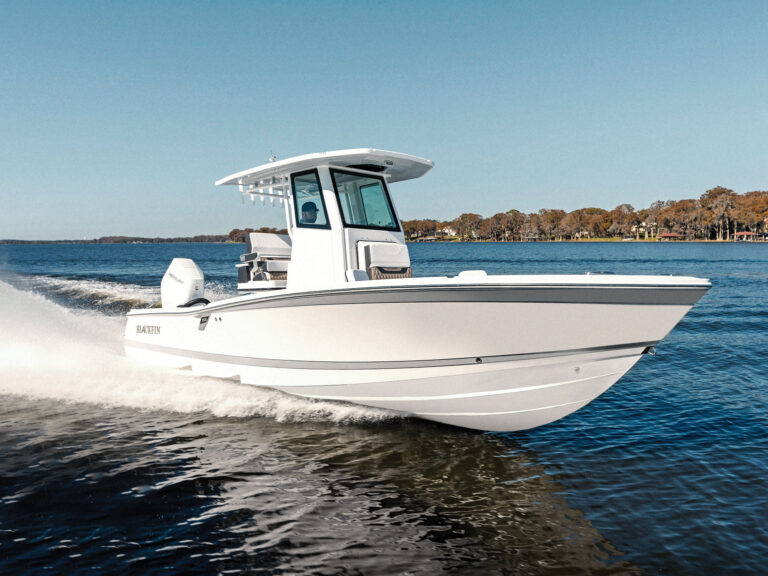
SPINNING WHEELS: One angler’s ideal prop may not meet the performance needs of another fisherman.
Photo: Jeff Stine
When i ordered my custom skiff three years ago, the builder hadn’t rigged any with an outboard like mine, so I decided to try the after-market brand of propeller he suggested. Bad choice. That particular stainless prop didn’t come close to delivering enough bow lift or top-end speed to suit me. Neither did the next four. The sixth time was finally the charm, although I’m facing that whole ordeal again-now that I have a new, larger horsepower engine on order. Multiply my experience around the coast and it’s easy to see why prop selection exasperates many boat owners.
If you buy a new boat and outboard from a dealer, most likely it will come with a standard “vanilla” propeller that works for the broadest range of boating scenarios. While that’s fine for occasional angling use, fishermen who regularly load half a tackle store, a mountain of ice and four large fishing buddies aboard a 26-footer for day trips to the canyons will probably regret that universal wheel. Vanilla props are also frustrating for someone trying to dial in a get-up-and-go hole shot in shallow water.
Pitch and Fit
This is where the prop swap comes into play. But before you break out the wrench and cotter pins, it helps to go over some propeller basics to find a good starting point.
Advanced hydrodynamic theory aside, the essence of propellers can be broken down into simple terms. Prop diameter is the measurement in inches across the circle traced by the rotating blade tips. Pitch is the distance in inches a propeller moves forward in one complete rotation. Props are designated by both. For instance, one stamped “14 1/2 5 17” would have a diameter of 14 1/2 inches with 17 inches of pitch. In laboratory conditions, this boat would move forward 17 inches with one revolution of the prop. “Slip” is the term used to describe the difference between abstract and actual travel, while ventilation refers to air from the water’s surface or engine exhaust gases sucked into the blades. For practical purposes, however, pitch is the key consideration.
“Pitch is the most important factor when selecting a prop,” says Kevin Fletcher, Mercury Marine’s propeller marketing manager. “It’s like a gear on a car. The lower the pitch, the better the torque and low-end power. Increase the pitch on the prop, and you shift into second gear for better speed and fuel economy.”
So that’s what the numbers mean. But how do you get the right number for your needs? “Choosing a prop is certainly not an exact science,” Fletcher says. “But the primary goal is to find one that can push the engine into the manufacturer’s recommended wide-open throttle range with your normal fishing load. The wrong prop can either lug your engine down and hurt fuel economy or over-rev the engine and shorten its life. After that it’s a matter of fine-tuning to meet your particular needs.”
To decide on the correct propeller for your fishing style, Fletcher recommends testing demonstrator props. Many dealers will have props available for this purpose. Under this program, a gentleman’s agreement or security deposit lets you try different sizes and kinds of props before you buy to see which one fits your performance preferences. For example, if you routinely fish offshore, you might want increased rake (backward blade slant) for more lift to keep from stuffing the bow in deep swells.
Built to Last
Construction and the number of blades are two more factors to ponder before you open your wallet. Fletcher doesn’t like aluminum propellers for salt, even in rock-infested water. His rationale is that stainless-steel props are five times stronger than premium aluminum models, so they remain consistent to manufactured specifications. And it’s a myth that aluminum blade shearing upon impact will prevent damage to the engine’s gear case.
“There’s less than a one-percent chance of gear damage with stainless-steel props,” Fletcher says. “And stainless is more durable than aluminum if you do nick something. Gear cases are protected by the propeller’s hub system, not the blades. That’s why hubs shouldn’t be made of super-hard materials. The good ones are designed to absorb shock rather than transfer that energy to the gears.”
Blade count is another performance issue. A three-bladed prop provides optimum efficiency throughout the engine range and is typically faster than a four-blade model. The fourth blade gives more control in high-speed turns, better torque during initial acceleration and increased maneuverability while docking. But that extra blade chips away at the top end because it has more material resistance in the water.
Bottom line? Selecting a stainless-steel propeller for your boat is a lengthy and pricey undertaking. Experiment beforehand to take the what-ifs out of the equation, and you’ll end up with a propeller that will provide years of satisfying performance.
Spin Doctor
The benefits of prop-tuning technology come to outboards.

|
|SAY VROOM: A prop checkup may upgrade performance. Photo: Tim Simos|
Large propeller facilities have been using Prop Scan computers to inspect and analyze propellers to achieve maximum performance for inboard-powered sportfishing and pleasure yachts for more than a decade. The technology also worked for outboards, but the cost and availability made work on smaller props prohibitive. The recent U.S. launch of Prop Tracker should change that. Portable and less expensive than the original, Prop Tracker computers can detect manufacturing flaws or otherwise unnoticeable damage on outboard props so they can be repaired to original specifications. The Prop Tracker can also precisely change a prop’s design or pitch to enhance overall performance. To find a Prop Tracker shop, call (877) 767-7226 or visit www.propscanusa.com.
– D.L.









